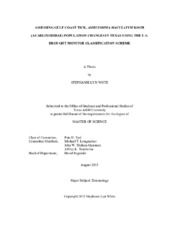| dc.description.abstract | Desiccation is the greatest risk to maximum survivorship during the off-host phase of ixodid tick (Acari: Ixodidae) life cycles. Ixodid tick development, survivorship and population responses have typically been assessed across habitat types in association with microclimate and mesoclimate temperature, precipitation, relative humidity, dew point or vapor pressure deficits, while assessment of ixodid tick populations at larger spatial scales have relied more upon macroclimate temperature and precipitation variables. We conducted a retrospective, observational study to assess Amblyomma maculatum Koch (Acari:Ixodidae) population changes using tick collection records and regional drought data for the state of Texas for the period 2000 – 2014.
Collection records containing A. maculatum were obtained from the Texas Animal Health Commission (TAHC) as submitted by inspectors at local county livestock markets. A “collection” was a single laboratory submission of one or more A. maculatum ticks. These records were assumed to be representative of A. maculatum abundance over time for each year in a 148 county study area. The Drought Mitigation Center, Lincoln, Nebraska provided Texas drought data from the U.S. Drought Monitor (USDM) for the same period and county area, based on their D0-D4 drought stress categories.
Repeated measures analyses were used to compare changes in A. maculatum collections and drought stress across the 15-year period between two adjacent geographical areas of Texas, defined as Coastal and Inland zones. Data were then combined, to test whether trends in A. maculatum population changes could be explained by corresponding changes in drought stress.
These analyses indicated significant difference (P = <0.0001) between the Coastal and Inland zone for tick collections, from June – November annually. There was significant interaction (P = <0.0001) between year and location for all drought stress categories. Subsequently, the combination of drought stress categories (D2-D4), across a 2-year lag was significant for both January – December and June – November tick collections, P = 0.0029 and P = 0.0043, respectfully.
These results support our hypothesis that A. maculatum population changes in Texas can be associated with drought stress levels of the USDM and a 2-year rolling predictive model is feasible. | en |


